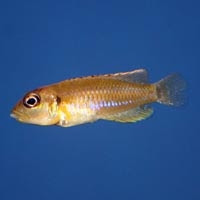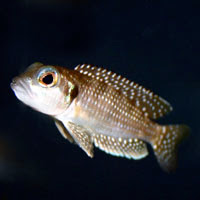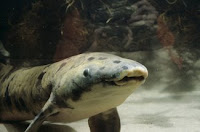
I’d like to welcome Jose Mendes to That Fish Blog. Jose is our resident Cichlid Pro. In addition to working at TFP for 13 years, he’s been breeding Cichlids for over 14 years and has produced over 200 different species. Check out Jose’s article below on setting up a Nano-cichlid habitat.
10 Gallon Rift Lake Cichlid Habitat
Working at That Fish Place/That Pet Place, I get a lot of questions regarding what type of African cichlids can be kept in small aquariums – particularly 10 gallon aquariums. Here I will try to answer some of the common questions concerning basic requirements and species specifics.
When a customer asks which cichlids are ok for a 10 gallon tank, I tell them to keep shell dwellers. These fish are from Lake Tanganyika and the majority of them only reach an adult size of 2 to 3 inches in length, though some do grow larger.
Let’s start with the tank itself. A regular 10 gallon glass tank is fine. For substrate, I prefer sand like Carib Sea Aragamax which I mix with Carib Sea Tahitian Moon black sand. The reason for choosing Aragamax is that not only does it help maintain the pH level in the aquarium, but it allows the fish to act naturally and bury their shells. My setup at home consists of a small cave in one corner and the remaining area is sand; into which I add 2 snail shells for each fish. For fish up to 2 inches I like shells the size of a quarter. (Medium turbo or apple shells work nicely.)
A 50 watt aquarium heater will be just fine. The temperature should be set between 78 and 80 degrees.
Filtration for this tank should be an outside power filter that turns the tank volume over 8 to 10 times an hour. Under gravel filters should be avoided!
The water chemistry in the lake is very hard with a pH of around 9.2. I’ve found from breeding shell dwellers that a pH of 8.4 or higher and a general hardness of at least 10 dkh is best for them.
Before I detail a few of the species, I’d like to share a few things I’ve learned from keeping and breeding these fish:
Weekly water changes: I’ve always done them and always will. 10% is enough to make a difference in health, vigor, and spawns.
Water conditions in my breeding tanks were all the same and were as follows: pH 8.6, General hardness 15+, and temperature 81 degrees.
For feeding; do not feed worms! Bloodworms, black worms, or tubifex. These will kill African cichlids sooner or later. Appropriate food would be any prepared small cichlid flake. They prefer sinking foods, but not necessarily pellets.
Have patience. Breeding shell dwellers is easy. Start out with a group of 5-6 individuals of one species. Don’t move the shells around and don’t add new fish. The fish will reward you for your diligence.
Now let’s detail some of the species that I would recommend for a 10 gallon aquarium. Once again do not mix more than one species per tank.
Lamprologus kungweensis: Adults reach lengths of 2.5 inches with females being slightly smaller than males. An identifiable trait of this species is the golden/yellow mark above each eye that becomes more apparent as they mature. Sexing is not easy there is not much dimorphism. Besides being smaller, the female is lighter in color and less intensely marked.
 Lamprologus ocellatus: A stunning 2 inch fish whose name means “eyespot” due to the distinctive spot, outlined in gold, on the fish’s operculum. In addition to the gill cover, the ocellatus has a gold colored iris, a golden cream colored body and clear fins speckled with blue or gold. Sexing is fairly easy; the male’s dorsal fin is edged in an orange/red band while the female’s is clearly paler and often edged in white. Also, mature females are rounded while males are more oblong in shape. The most distinctive feature of a pair is the size difference. Males are almost ½ inch larger than females and the teeth appear larger and more prominent. One of my favorite shell dwellers on the market is the Golden Ocellatus, which has a golden sheen to the whole body.
Lamprologus ocellatus: A stunning 2 inch fish whose name means “eyespot” due to the distinctive spot, outlined in gold, on the fish’s operculum. In addition to the gill cover, the ocellatus has a gold colored iris, a golden cream colored body and clear fins speckled with blue or gold. Sexing is fairly easy; the male’s dorsal fin is edged in an orange/red band while the female’s is clearly paler and often edged in white. Also, mature females are rounded while males are more oblong in shape. The most distinctive feature of a pair is the size difference. Males are almost ½ inch larger than females and the teeth appear larger and more prominent. One of my favorite shell dwellers on the market is the Golden Ocellatus, which has a golden sheen to the whole body.
Lamprologus ornatipinnis: As the name implies, the appeal of this species lies in its ornate fins which are distinctively marked with a series of striations that vary in color from purple to black. While a mature male may reach a total length of 2 inches, the females are ½ inch smaller. The female is also considerably plumper with a metallic purple sheen developing over the abdomen as she comes into breeding condition.
Lamprologus signatus: Another small but striking shellie, males top off at 2 inches, females slightly smaller. L. signatus are more elongate or torpedo shaped than other Lamprologus species. These display clear sexual dimorphism. The flanks of the males are crossed by dark vertical bands that extend through the dorsal to anal fins. The females are drab with only a slight pink hue to their abdomen.

Neolamprologus brevis: At less than 2 ¼ inches N. brevis is a shiny beige color with up to nine silvery-white bands. Iridescent pastel blue striations mark the upper jaw, the cheek, and the anterior third of the body. Females are slightly smaller and show fewer extensions of the pectoral fins.
Neolamprologus boulengeri: Attaining a length of 2 ½ inches, N. boulengeri is an attractively marked shell dweller. In addition to the characteristic blotch pattern across the flanks, they have a yellow/orange margin in the dorsal and anal fins. The upper jaw sports a vivid metallic blue moustache which continues as a thin blue iridescent stripe across the operculum and flank.

Lamprologus meleagris: The so called “lace lamp” or “pearly ocellatus”, L. meleagris is a diminutive silvery/black cichlid that rarely exceeds 2 ½ inches in total length. Its flanks are purplish with a series of irregular pearl like spots that highlight the scales and fins. The throat is silvery with hint of blue; the eye is set off by a bright blue streak behind the orbit. Females are smaller than males and their colors are not as intense, even when breeding.
Neolamprologus multifasciatus: The smallest of the shell dwelling cichlids of Lake Tanganyika. As the name implies, N. multifasciatus has a “many striped” pattern over its body. The edges of the caudal, anal, and dorsal fins are highlighted with bands of yellowish/orange and white. Sexing mature specimens is simple because though the female is marked the same as the male, she is fully grown at under 1 inch, while the male reaches 1 ¼ inch.
Neolamprologus similis: Similar in appearance to N. multifasciatus but with a larger eye and greenish/brown body color and contrasting light green markings. The bands extend further over the forehead of the fish. Adult size is nearly identical to N. multifasciatus as well.
In closing, I would have to say that shellies are the type of cichlid for people who want to keep cichlids but don’t have the room for a larger tank, (especially college students) and their natural breeding behavior is fun to watch. They are a lot of personality packed into a small fish!

 That Fish Blog – Aquarium Advice and Information
That Fish Blog – Aquarium Advice and Information










